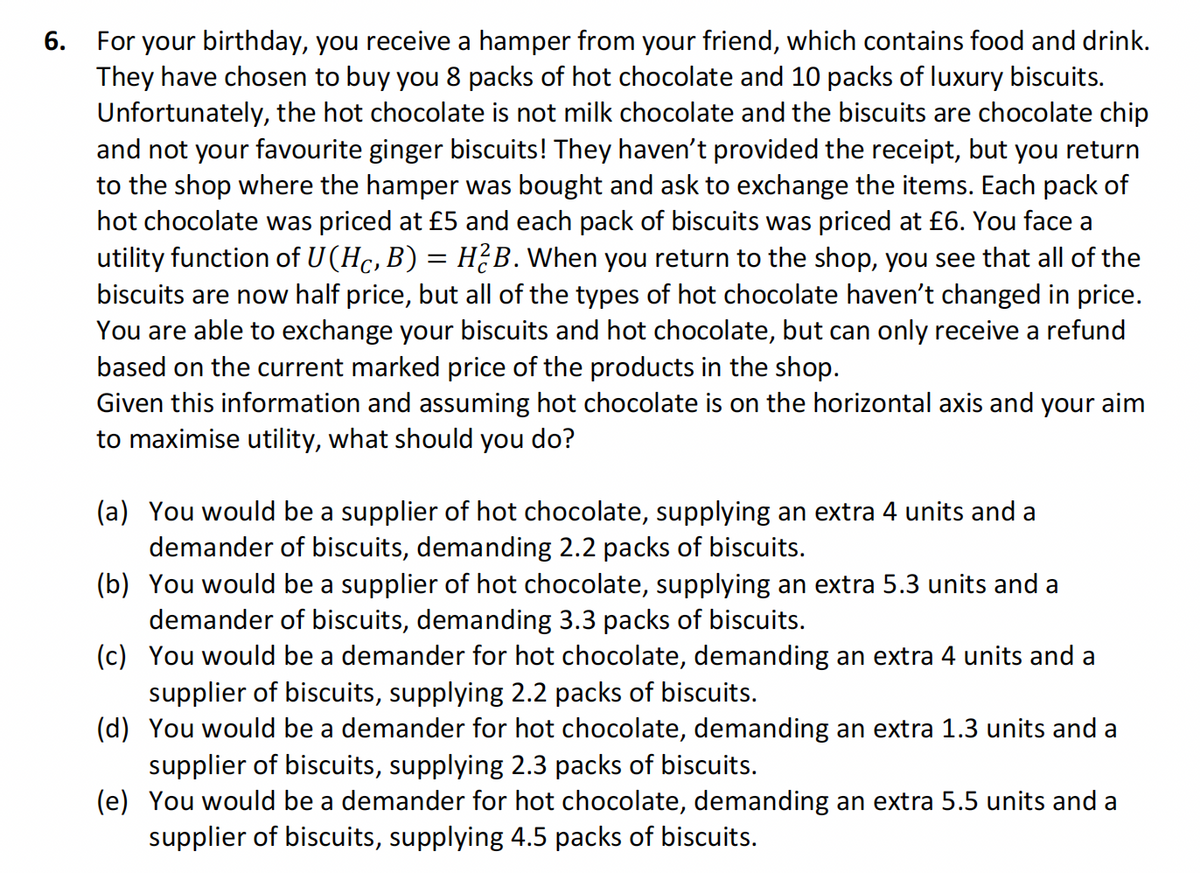6. For your birthday, you receive a hamper from your friend, which contains food and drink. They have chosen to buy you 8 packs of hot chocolate and 10 packs of luxury biscuits. Unfortunately, the hot chocolate is not milk chocolate and the biscuits are chocolate chip and not your favourite ginger biscuits! They haven't provided the receipt, but you return to the shop where the hamper was bought and ask to exchange the items. Each pack of hot chocolate was priced at £5 and each pack of biscuits was priced at £6. You face a utility function of U (Hċ, B) = H²B. When you return to the shop, you see that all of the biscuits are now half price, but all of the types of hot chocolate haven't changed in price. You are able to exchange your biscuits and hot chocolate, but can only receive a refund based on the current marked price of the products in the shop. Given this information and assuming hot chocolate is on the horizontal axis and your aim to maximise utility, what should you do?
6. For your birthday, you receive a hamper from your friend, which contains food and drink. They have chosen to buy you 8 packs of hot chocolate and 10 packs of luxury biscuits. Unfortunately, the hot chocolate is not milk chocolate and the biscuits are chocolate chip and not your favourite ginger biscuits! They haven't provided the receipt, but you return to the shop where the hamper was bought and ask to exchange the items. Each pack of hot chocolate was priced at £5 and each pack of biscuits was priced at £6. You face a utility function of U (Hċ, B) = H²B. When you return to the shop, you see that all of the biscuits are now half price, but all of the types of hot chocolate haven't changed in price. You are able to exchange your biscuits and hot chocolate, but can only receive a refund based on the current marked price of the products in the shop. Given this information and assuming hot chocolate is on the horizontal axis and your aim to maximise utility, what should you do?
Chapter17: Capital And Time
Section: Chapter Questions
Problem 17.8P
Related questions
Question

Transcribed Image Text:6. For your birthday, you receive a hamper from your friend, which contains food and drink.
They have chosen to buy you 8 packs of hot chocolate and 10 packs of luxury biscuits.
Unfortunately, the hot chocolate is not milk chocolate and the biscuits are chocolate chip
and not your favourite ginger biscuits! They haven't provided the receipt, but you return
to the shop where the hamper was bought and ask to exchange the items. Each pack of
hot chocolate was priced at £5 and each pack of biscuits was priced at £6. You face a
utility function of U (Hċ, B) = H²B. When you return to the shop, you see that all of the
biscuits are now half price, but all of the types of hot chocolate haven't changed in price.
You are able to exchange your biscuits and hot chocolate, but can only receive a refund
based on the current marked price of the products in the shop.
Given this information and assuming hot chocolate is on the horizontal axis and your aim
to maximise utility, what should you do?
(a) You would be a supplier of hot chocolate, supplying an extra 4 units and a
demander of biscuits, demanding 2.2 packs of biscuits.
(b) You would be a supplier of hot chocolate, supplying an extra 5.3 units and a
demander of biscuits, demanding 3.3 packs of biscuits.
(c)
You would be a demander for hot chocolate, demanding an extra 4 units and a
supplier of biscuits, supplying 2.2 packs of biscuits.
(d) You would be a demander for hot chocolate, demanding an extra 1.3 units and a
supplier of biscuits, supplying 2.3 packs of biscuits.
(e) You would be a demander for hot chocolate, demanding an extra 5.5 units and a
supplier of biscuits, supplying 4.5 packs of biscuits.
Expert Solution
This question has been solved!
Explore an expertly crafted, step-by-step solution for a thorough understanding of key concepts.
Step by step
Solved in 3 steps with 7 images

Knowledge Booster
Learn more about
Need a deep-dive on the concept behind this application? Look no further. Learn more about this topic, economics and related others by exploring similar questions and additional content below.Recommended textbooks for you


Principles of Economics 2e
Economics
ISBN:
9781947172364
Author:
Steven A. Greenlaw; David Shapiro
Publisher:
OpenStax


Principles of Economics 2e
Economics
ISBN:
9781947172364
Author:
Steven A. Greenlaw; David Shapiro
Publisher:
OpenStax